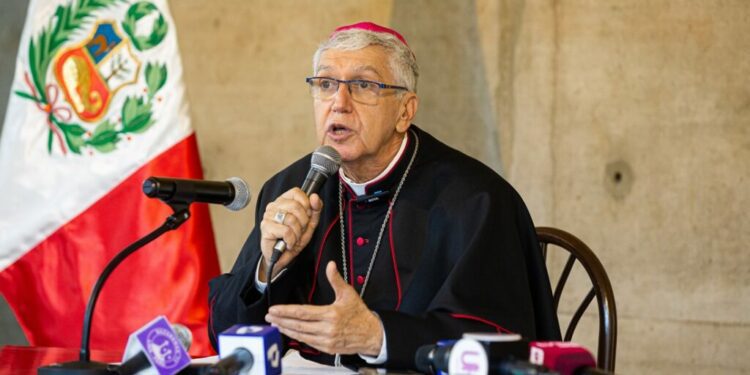ROME – Cardinal-designate Carlos Castillo of Lima has penned an article in a prominent Spanish newspaper has called for the suppression of Peru’s Sodalitium Christianae Vitae (SCV), calling it a toxic mix of fascist religiosity.
In a column published in El Pais Oct. 19, Castillo said his hypothesis is that the SCV “is the resurrection of fascism in Latin America, using the church cunningly, through sectarian methods, testing how strong you are or forcing you to sleep face down on stairs to forge your character.”
“In other words, pure Pelagian asceticism,” he said, saying these methods ultimately lead to “a mental control of people who end up becoming armies of robots that conquer and dominate.”
“This experiment was bought by well-intentioned people who believed it was a good project to fight for in Peru. But this is not the way. Not the way of sectarian manipulation,” he said, saying, “As a failed experiment, it should be suppressed by the church.”
Castillo, 73, was named archbishop of Lima in 2019, and is among the new cardinal-appointees who will get a red hat from Pope Francis on Dec. 7, the eve of the solemnity of the Immaculate Conception and ahead of the Dec. 24 inauguration of the Jubilee of Hope.
His elevation as cardinal takes place as the Vatican is in the midst of conducting an inquiry into the SCV, founded by Peruvian layman Luis Fernando Figari in 1971, and which has been marred in scandal for the past decade surrounding allegations of physical, psychological and spiritual abuse, as well as sexual abuse and abuses of power, conscience and authority on the part of Figari and other top members.
After several failed attempts at reform, the pope last year sent his top investigating team – Archbishop Charles Scicluna of Malta, an adjunct secretary of the Vatican’s Dicastery for the Doctrine of the Faith (DDF), and Spanish Monsignor Jordi Bertomeu, an official of the dicastery – to Lima to investigate the SCV amid ongoing allegations of abuse and financial corruption.
Figari, who had previously been sanctioned by the Vatican in 2017, was expelled from the SCV in August, and last month the Vatican as part of its inquiry expelled 10 top members of the group.
In his column, Castillo recounted his longstanding knowledge of Figari and the birth and growth of the SCV, as well as its early resistance to so-called liberation theology in Latin America and its sectarian treatment of members.
Castillo said the first saw Figari in 1968, while he was concluding a term as president of the Catholic Student Youth (JEC) initiative, and Figari and another friend, Sergio Tapia, showed up uninvited at a meeting they were holding to discuss funding a school in one of Peru’s shanty towns.
During that meeting Figari, 21 at the time, and Tapia, who later became a lawyer with ties to the Peruvian navy, encouraged students to join a fascist-inspired group they were involved with called the Revolutionary Union.
According to Castillo, Tapia was a student at the Marist school Champagnat, while Figari attended the Our Lady of the Marianists school, where he met a priest by the name of Father Óscar Alzamora, who in 1983 was named bishop of the Tacna province and was known for his critiques of feminism.
It was at that school that Figari also came into contact with a priest named Father Gerald Haby, who promoted an initiative popular with the Marianists in the 1960s called the Sodality of the Virgin Mary.
It was Figari, Tapia, and Haby who co-founded the SCV together in 1971, Castillo said, saying Tapia eventually drifted into politics, whereas Figari, who had studied law and theology, “disguised himself with religion” and eventually took over the group.
“He used religion as a cap, since his project was above all political and, later, money-raising,” Castillo said.
Castillo said Figari and Tapia were “booed and rejected outright” in their attempt to get students to join the Revolutionary Union, as many students were opposed to the politicization of JEC activities.
“I remember that they said goodbye defiantly, and with their hands raised, shouting fascist slogans,” he said.
Around this time Peruvian theologian Gustavo Gutiérrez had started to gain attention with his writings, Castillo said, saying he first met Gutiérrez between 1969-1970, while in his second and third year of university, as Gutiérrez was national advisor to the National Union of Catholic Students (UNEC).
In July 1969, Gutiérrez wrote a text for a theological congress in Geneva about the Theology of Development which the UNEC wanted to reprint, however, Gutiérrez, Castillo said, instructed them, “don’t call it ‘Toward a theology of development,’ but ‘Toward a theology of liberation.’”
“As university students committed to the poor, we observed the profound change that was taking place in our Peruvian society,” due to migration as well as natural disasters such as the May 1970 earthquake that left 80,000 people dead.
Those arriving in Lima at the time “demanded from us a greater social awareness and commitment,” Castillo said, saying that it was in this context that the Peruvian version of Gutiérrez’s text, “Theology of Liberation: Perspectives,” was published.
Castillo said he had taken a year off from studies in 1973 to serve as a sociology instructor in a mining town called Cerro de Pasco in order to get to know the country better before entering seminary. It was during this year, he said, that he saw a sharp critique build against Gutiérrez, largely led by Figari.
“In a context of strong social tension and in the midst of an increasingly intense theological debate, the church grew in the popular communities of the peripheries,” he said, saying that in response to Gutiérrez’s text, in 1979 another book was published by Alfredo Garland titled, “Like ravenous wolves: Peru, an infiltrated church?” criticizing Gutiérrez.
Figari was behind Garland’s book, Castillo said, saying that it was from here that “the whole drama of the unjust persecution of Father Gustavo Gutiérrez began.”
“From the start, that insane response was, at its core, an attack on Cardinal Juan Landázuri,” the former archbishop of Lima, who Castillo said was too “open-minded” for Figari and his acolytes, who from the beginning styled Landázuri and Gutiérrez as leftists.
Instead, he said, Gutiérrez “was simply a man open to the Gospel and to the signs of the times, who updated the faith for our poor and deeply religious continent.”
Castillo said that he returned to Lima in 1979 and asked Landázuri to be admitted for philosophical studies in the seminary. His spiritual guide at the time, he said, was a missionary of the Sacred Heart named Father Germán Schmitz, named auxiliary bishop of Lima in 1970.
Schmitz, Castillo said, was charged with the formation of pastoral agents and was one of the main editors of the Puebla Document, written for the Latin American bishops’ conference in 1979 and which was widely considered a landmark moment in development of liberation theology on the continent.
Castillo said Schmitz’s “preferential option for the poor” and fidelity to the Gospel were in sharp contrast with news he was hearing coming out of the newly-formed SCV, which consisted of “elitist ideological slogans, simplistic thinking, rejection of rational analysis.”
“I also learned that the Sodalitium, with the intervention of the young priest Jaime Baertl, had converted a piece of land in Lurín, a district south of Lima donated by the Aguirre Roca family, into a private tax-free cemetery,” he said, adding, “Thus began the economic takeoff of the Sodalitium.”
RELATED: Controversial lay group in Peru denies charges of tax dodging, fiscal fraud
Around this time the SCV began to gain a reputation in Rome, Castillo said, saying he was studying in the Eternal City from 1979-1987 and heard curial officials in the Vatican describe Figari as an “exemplary layman” and a “vanguard of the solution” to the problems of the post-conciliar church in Latin America.
He said the SCV consistently criticized Gutiérrez and his work and accused them of trying to thwart an inquiry into his works, but said Gutiérrez was cooperative and was ultimately “the truth emerged” and Gutiérrez “was saved” by then then-prefect of the DDF, Joseph Ratzinger.
“Without a doubt,” Castillo said, the SCV and its ecclesial allies “were on the verge of doing something serious with Gutiérrez,” which ultimately came to nothing, whereas their “Theology of Reconciliation” remained “a mere slogan.”
Castillo said the SCV continued to grow and gain prominence in Peru and Latin America, and that several laymen and priests with influence among upper classes in joined, but “ended up disillusioned.”
He said the SCV’s canonical approval, supported by Archbishop Mario Tagliaferri and Archbishop Luigi Dossena, who collectively served as nuncio to Peru from 1978-1994, was “riddled with irregularities.”
Castillo said that when he returned to Lima as a priest in 1987 and was made vicar of young people involved the university pastoral activity, the SCV wanted to “take over” university chapels in the country by putting their logos and symbols inside.
“They accused me of prohibiting them from having a space because I wouldn’t let them put up their placard,” he said, saying they sent a complaint about him to Cardinal Augusto Vargas, at the time archbishop of Lima.
Vargas later told him, he said, was that “the people from the Sodalitium were just here and I told them that this is not the Gestapo.”
“He had had enough of so much instrumentalization by this hermetic and elitist religious group,” Castillo said, saying the next few years “would confirm that this appearance of ecclesial perfection, praised and celebrated by a part of the hierarchy, hid a murky and disturbing reality.”
Castillo said that when he was named archbishop of Lima in 2019, a Jesuit told him that a young man needed to speak with him urgently.
That man, Castillo said, was someone who had left the SCV after they had given him pills for schizophrenia, which he never suffered from but contracted as a result of using the pills. The man said he had to pay a debt that he had incurred when he bought the medicines and couldn’t afford it, and wanted compensation.
The man, Castillo said, told him that the SCV “experimented on me,” and that after listening to the man’s story, he ordered the SCV to pay the man enough to cover his debts, which they did.
After this experience, he said, as a theologian and sociologist he began to question what the SCV and similar movements are, concluding that now, “It’s not just politics, as in its beginnings; now it is religion instrumentalized for a political plan.”
“Figari agrees with Marcial Maciel, founder of the Legionaries of Christ, a personally depraved man with a political-economic project hidden behind a religious façade,” he said, saying the man he met who was experimented on “was not the only one.”
He named victims who were essentially forced into servitude of Figari and top members, saying their methods consist of “servility and mental control.”
Recalling a line from the book “History of the Indies” by Bartolomé de las Casas, Castillo said, “The conquerors like all tyrants always try to disrupt the understanding of the Indians by making them pusillanimous so that they do not think about their freedom.”
“The Sodalicio has destroyed people, subjecting them to their interests of conquest. There is nothing Christian about this,” he said, saying the SCV in his view was an attempted “resurrection of fascism in Latin America” through sectarian means that ultimately failed.
Castillo voiced his belief that “if Latin America is a Catholic reserve subject to a thousand and one foreign interests, entities like the Sodalitium prevent a change from developing there.”
Other orders such as the Jesuits or the Dominicans, he said, “sought a social change with the contribution of the faith,” whereas movements such as the SCV “are a total reduction and the political change they seek, their fight against Marxism in this case, involves subjugating people.”
“The use of religion for purposes other than the extension of the Good News of Jesus is the most destructive thing for the Catholic Church. Therefore, I have come to the conclusion that there is no charisma in the Sodalitium,” he said.
Castillo argued that an order or movement only has a genuine charisma when a founder “receives a gift from the spirit for the whole church and his works are good. The founder and the group can make mistakes and sins, but the balance is highly positive because of the good works generated.”
In the case of the SCV and the three other entities founded by Figari – the Marian Community of Reconciliation, the Servants of the Plan of God, and the Christian Life Movement – this is not the case, he said.
Figari, Castillo said, “verified as an abuser, and with him a large part of the founding nucleus and others, invented an alleged charisma to protect a political and sectarian project.”
“But is not the way. Not the way of sectarian manipulation,” Castillo said, voicing his belief that the SCV “and the other groups founded by Figari cannot be saved because they were born badly and their fruits over the last 50 years demonstrate this.”
“At the service of the Latin American cold war, it has been a machine for destroying people, inventing a faith that conceals its crimes and its ambition for political and economic domination,” he said, adding, “there is nothing spontaneous in its members.”
“There is no freedom and without freedom there is no faith,” he said, adding, “As a failed experiment, it should be suppressed by the church.”
Follow Elise Ann Allen on X: @eliseannallen
Source link : http://www.bing.com/news/apiclick.aspx?ref=FexRss&aid=&tid=67161fc2f91a495f9f31afe98ddaeea8&url=https%3A%2F%2Fcruxnow.com%2Fchurch-in-the-americas%2F2024%2F10%2Fnew-lima-cardinal-calls-scandalous-peru-group-a-failed-resurrection-of-fascism&c=12876902249123251085&mkt=en-us
Author :
Publish date : 2024-10-20 21:37:00
Copyright for syndicated content belongs to the linked Source.






